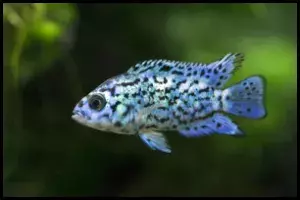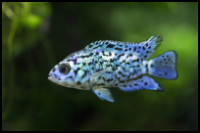
Quick Care Details (Table)
| Livestock Characteristics | Value |
|---|---|
| Care Level | Moderate |
| Temperament | Aggressive |
| Diet | Omnivorous |
| Maximum Size | 10 inches (25 cm) |
| Minimum Tank Size | 55 Gallons |
| Plant Safe | No |
| Temperature Range | 75-82°F (24-28°C) |
| PH Range | 6.5-7.5 |
| KH Range | 4-10 dKH |
| GH Range | 6-15 dGH |
Species Specific Categories
Helpful Video
Care Details
- Aquascape
The Electric Blue Jack Dempsey (Rocio octofasciata) thrives in a well-planned aquascape that mimics its natural habitat. Include driftwood, rocks, and plenty of hiding spots to help reduce stress and support its territorial behavior. Live plants are optional but should be hardy varieties like Anubias or Java Fern, as they may uproot softer plants. - Substrate
A sandy substrate is ideal for Rocio octofasciata, as it allows them to dig and sift naturally. Avoid sharp gravel, which could harm their delicate barbels or scales. - Disease Prevention
Keeping the water parameters stable is key to preventing diseases. Regular water changes, a high-quality filter, and not overstocking the tank help maintain optimal conditions. Quarantine new fish and plants to avoid introducing parasites or illnesses to your aquarium. - Filtration
The Electric Blue Jack Dempsey requires robust filtration to handle its bioload, as they are messy eaters. A canister or high-capacity hang-on-back (HOB) filter works best. Supplemental sponge filters can also enhance oxygenation and biofiltration. - Lighting
Moderate lighting works well for Rocio octofasciata. Intense lighting is unnecessary and may cause stress. If you include plants, choose lighting that supports plant growth but doesn’t overpower the fish's comfort zone. - Water Flow
A low to moderate water flow is suitable for this species. They prefer calm waters similar to their natural environment. Use adjustable filters or position outlets to ensure water movement doesn’t create excessive currents. - Hardiness
The Electric Blue Jack Dempsey is relatively hardy but sensitive to sudden changes in water parameters. Maintaining stable pH, hardness, and temperature will ensure their health and well-being. - Acclimation
Acclimate Rocio octofasciata slowly to their new environment using a drip or slow water mixing method. This prevents shock due to differing water parameters from their previous habitat. - Expected Lifespan
With proper care, the Electric Blue Jack Dempsey can live 8–10 years in captivity, making them a long-term commitment for dedicated aquarists. - Special Requirements
Provide plenty of space as Rocio octofasciata can grow up to 8 inches in length. A minimum tank size of 55 gallons is recommended for a single fish, with larger tanks needed for additional tank mates. Balanced, high-quality foods with occasional protein-rich treats like brine shrimp or bloodworms are crucial for vibrant coloration and health.
Temperament and Behavior
- Behavior
Electric Blue Jack Dempseys (Rocio octofasciata) are generally shy compared to their standard counterparts, especially when young or newly introduced. Once acclimated, they become more confident and display curious, exploratory behavior. They often stake out territories and can be seen rearranging substrate or inspecting their environment. - Breeding
Breeding Rocio octofasciata in captivity is possible but requires a carefully planned setup. They are substrate spawners, often choosing flat rocks or digging shallow pits in the substrate for egg-laying. A bonded pair will clean and guard the chosen site. Eggs hatch within 2–3 days, and the parents fiercely protect the fry. Raising fry requires high-quality food like baby brine shrimp or powdered fry food. - Aggression
While less aggressive than standard Jack Dempseys, the Electric Blue variety can still exhibit territorial aggression, particularly during breeding. Providing enough hiding spots and maintaining proper stocking levels helps minimize conflicts. - Tankmates Compatibility
Ideal tankmates for Rocio octofasciata include medium-sized, peaceful or semi-aggressive fish that can hold their own without being overly dominant. Examples include Severums, Rainbowfish, and Silver Dollars. Avoid overly aggressive cichlids or tiny fish that may be seen as prey. - Activity Level
They are moderately active, often patrolling their territory or interacting with tank mates. Their movements are slower and deliberate compared to highly active species like tetras or barbs. - Schooling or Shoaling Behavior
Electric Blue Jack Dempseys are not schooling fish and prefer to live singly or in bonded pairs. Keeping multiple adults in a confined space can lead to territorial disputes. - Plant Compatibility
Rocio octofasciata are moderately plant-friendly. While they may occasionally uproot plants during digging, hardy species like Anubias, Java Fern, or Cryptocoryne are less likely to be damaged. Anchoring plants securely to rocks or driftwood can help protect your aquascape.
Diet and Nutrition
- Dry Foods
These fish thrive on high-quality dry foods like pellets or flakes formulated for cichlids. Look for options rich in proteins and natural color enhancers, such as spirulina and astaxanthin. Sinking pellets are especially effective for their bottom-feeding habits. - Frozen Foods
Offer frozen options such as bloodworms, brine shrimp, krill, and daphnia for protein and variety. Feeding these once or twice a week helps maintain vibrant coloration and overall health. - Live Foods
Live foods like feeder shrimp, blackworms, and insect larvae are great additions to mimic their natural diet and encourage hunting behavior. Ensure live feeders are disease-free to prevent introducing parasites. - Vegetables
Blanched vegetables such as zucchini, shelled peas, and spinach make excellent supplements. These provide essential nutrients and aid digestion. - Algae
While not primary algae eaters, they may nibble on it occasionally. Algae wafers can be offered sparingly, particularly in community setups. - Feeding Schedule
Feed small portions 2–3 times daily, ensuring all food is consumed within a few minutes. Avoid overfeeding, and promptly remove uneaten food to maintain water quality. - Supplemental Foods
Treat them occasionally with freeze-dried shrimp, tubifex worms, or plankton for added nutrients and variety.
Tank Parameters
- Tank Size
A minimum of 55 gallons is recommended for one adult. If you plan to keep a pair or add tank mates, aim for 75 gallons or larger to provide ample space and reduce territorial conflicts. - Tank Length and Measurements
Length is more critical than height for these fish. A tank at least 4 feet long is ideal, as it provides enough horizontal swimming space and room to establish territories. - Water Temperature
Maintain a stable temperature between 76°F and 82°F (24°C to 28°C). A reliable heater and thermometer are essential to prevent sudden fluctuations. - pH (Acidity/Alkalinity)
These fish prefer slightly acidic to neutral water, with a pH range of 6.5 to 7.5. Keep the pH stable to avoid stress and health issues. - KH (Carbonate Hardness)
Aim for a KH between 4 and 8 dKH. This helps stabilize the pH and provides a comfortable environment for the fish. - GH (General Hardness)
A GH level of 6 to 12 dGH is suitable. Moderately hard water mirrors their natural habitat and supports healthy osmoregulation. - Hardiness
They are moderately hardy fish but sensitive to sudden changes in water conditions. Consistent maintenance of parameters is crucial to avoid stress and illness. - Nitrate (NO3) Levels
Keep nitrate levels under 20 ppm to maintain optimal water quality. Regular water changes and proper filtration are essential to control waste buildup.
History, Popularity, History and Species Variety Details
The History, Popularity, and Natural Habitat
- History
The Electric Blue Jack Dempsey (Rocio octofasciata) is a selectively bred variation of the standard Jack Dempsey, which originates from freshwater bodies in Central America, particularly in Mexico, Honduras, and Guatemala. This unique color morph was developed through years of breeding for its striking iridescent blue coloration, which distinguishes it from the more subdued colors of its wild relatives. The species name, Rocio octofasciata, reflects its original discovery and description in the early 20th century. The term "Jack Dempsey" itself was coined due to the fish's bold, "punchy" temperament, likened to the famous heavyweight boxer of the 1920s. The Electric Blue variety emerged in the aquarium trade as a response to hobbyists' demand for visually stunning and less aggressive fish. - Popularity
The Electric Blue Jack Dempsey has surged in popularity among aquarists due to its dazzling coloration and manageable temperament compared to its wild counterparts. It appeals to hobbyists who enjoy cichlids but seek a less aggressive option suitable for more diverse tank setups. Their combination of vibrant hues and relatively adaptable care requirements makes them a favorite for mid-sized aquariums. While initially rarer and more expensive due to their selective breeding, advancements in breeding techniques have made them increasingly accessible, solidifying their place as one of the most sought-after cichlids in the hobby. - Natural Habitat
In the wild, Rocio octofasciata inhabits slow-moving rivers, lakes, and ponds with warm, slightly acidic to neutral water. These environments are often characterized by sandy or muddy substrates, dense vegetation, and plenty of hiding spots like rocks and submerged branches. While the Electric Blue variety doesn’t occur naturally in the wild, its care requirements mimic those of its natural relatives, emphasizing stable water parameters and a habitat with plenty of cover to reduce stress. Their natural habitats are rich in biodiversity, which has shaped their diet and behavior over generations.
Similar and Variations of the Species
- Similar Fish Species
- Standard Jack Dempsey (Rocio octofasciata)
- Firemouth Cichlid (Thorichthys meeki)
- Convict Cichlid (Amatitlania nigrofasciata)
- Green Terror Cichlid (Andinoacara rivulatus)
- Salvini Cichlid (Trichromis salvini)
- Variations
- Electric Blue Jack Dempsey
- Electric Blue Gene Carrier (dull coloration but passes on Electric Blue traits)
- Gold Jack Dempsey (a rare morph with a golden hue)
- Long-Fin Jack Dempsey (exhibits elongated fins for a more dramatic appearance)
Personal Perspective
I’ll never forget the first time I introduced an Electric Blue Jack Dempsey to my tank. Watching its vibrant blue hues shimmer under the aquarium lights was mesmerizing, but what truly amazed me was how quickly it adjusted to its new home. Over time, it became the star of the tank, greeting me during feeding times and boldly exploring every nook and cranny of its aquascape. Its blend of striking beauty and interactive behavior made it more than just a fish—it felt like a true companion in my aquatic journey.
Frequently Asked Questions
How can I distinguish between a juvenile Electric Blue Jack Dempsey and a regular Jack Dempsey?
Juvenile Electric Blues are lighter in color and often have a metallic sheen, even at a young age, compared to the darker and more muted tones of regular Jack Dempseys.
What tankmates can coexist peacefully with this species?
Ideal tankmates include medium-sized, non-aggressive fish like rainbowfish, giant danios, or larger tetras. Avoid overly aggressive or small, delicate species that might become targets.
Do they require any special lighting to enhance their coloration?
Standard aquarium lighting works well, but LEDs with adjustable spectrums can bring out their stunning blues even more. Keep lighting consistent to avoid stress.
How can I manage aggression during breeding periods?
Provide plenty of hiding spots and visual barriers, such as rocks and plants. Separating the breeding pair from tankmates during spawning can reduce conflicts.
Can their color intensity fade, and how can I maintain their vibrancy?
Color fading often results from stress, poor water quality, or an unbalanced diet. Ensure a varied, protein-rich diet and maintain pristine water conditions to keep their hues vibrant.


